Sweet Cicely – Edibility, Identification, Distribution
Myrrhis Odorata
- Edibility – 4 – leaves, flowers, seeds and roots
- Identification – 4 – Quite recognisable by its smell, hairs and (usually) white blotches, but the leaf structure is very similar to poison hemlock so novices should be very careful to definitively identify. Please see my Introduction to the Carrot/Apiaceae Family for Foragers for more information.
- Distribution – 3 – Quite common in Northern England and Scotland – scarce in S England. There are areas of NE Scotland where sweet cicely vies with cow parsley as the dominant roadside umbellifer.
- Season – March – July (seeds may still be found later and I have occasionally noticed autumnal leaf growth right into November on a mild year)
- Habitat – Moist hedgerows, field edges, roadsides, stream sides. Often found near human habitation.
Despite being a member of the often scary carrot family, this gorgeous plant is one I recommend to novice foragers. Many tasty wild foods make you work for your reward by being hard to tell from something more sinister. Not so sweet, generous cicely who kindly displays her edibility with two obvious and distinctive characteristics.
Any part of the plant, from the light green lacy leaves, to the delicate umbels of white flowers and the long, pointed seeds, smell of sweet aniseed when crushed. This could be sufficient to identify the plant (edible fennel has the only similar scent), but as the leaves are really rather similar in structure to hemlock (though softer and less glossy), best wear belt and braces by checking for pale “splashes” on the leaves. This looks to me like someone has splashed diluted tippex over their bases – its quite a random distribution and some leaves, and occasionally whole plants will lack any pale markings. Just leave them if you aren’t certain – or check out this page: Know Your Carrots!
Sweet cicely offers many sensual pleasures to the forager. There is an ampleness and generosity in her growth that is pleasing to the eye – seldom taller than a metre or so, but always appearing substantial without being solid. The leaves look bright and lacy and feel soft to the touch while umbels of tiny cream inflorescences float above. Even the scent is ephemeral – leaves sometimes seem noticeably sweet and aniseedy without being touched, but fade quickly after picking. This is not a plant to keep hanging about in your fridge, but that is unlikely to happen.
Aniseed naturally complements fish if applied judiciously. I have successfully filled belly cavities of sea bass and mullet with sweet cicely fronds before barbecuing, or added them with a splash of wine and other spring herbs when baking fish en papillotte. Salads reach new heights with a few leaves mixed through.
Anise aromas are surprisingly common in fungi and I like to enhance this by stuffing horse mushrooms with it. See the recipe here.
Fill your pockets with its delectable aniseed-sweety-seed pods and spread them about your mouth and the countryside.
It isn’t hard to imagine this plant being held in high regard during times when sweet flavours were harder to come by. It can add a new dimension to a bowl of berries – and I have combined it with japanese knotweed to make both a sorbet and a sauce for guinea fowl.
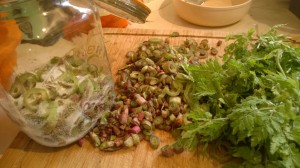
Making japanese knotweed and sweet cicely vodka. These 2 ingredients combine exceptionally well – try them in ice cream, jams, fools, cumbles too
Drinks uses of sweet cicely
The sweet aromatics of sweet cicely transfer readily into liquids. Try steeping some (stems, leaves, flowers, seeds – the lot) in vodka for a few weeks to make a great anise schnapps. I use this schnapps in an atomiser to spray a hint of anise onto cocktails. Leaves can also be rapidly infused into water using an N2O cream whipper to make an elegant and refreshing soda. I have also successfully used the flowers instead of elderflowers to make a champagne (you’ll need to put lots of blooms in – they aren’t as pungent as elderflowers. I wrote this article on further drinks uses of sweet cicely.
But my greatest pleasure with this plant is to suck on its proudly presented seed pods as I walk around the Fleet Valley – natural and delicious sweeties!
Related pages:

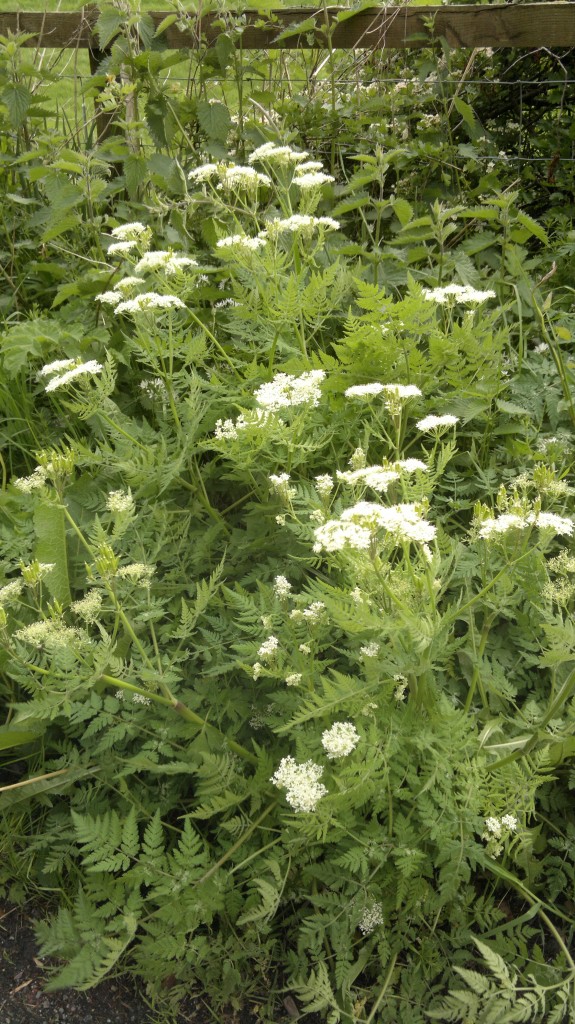
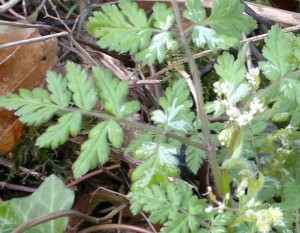
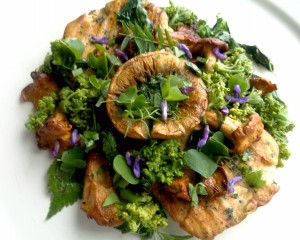

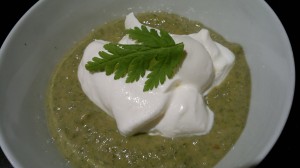
23 Comments
Does sweet cicely only have an aroma in its second season.? I have some growing profusely in a big tub but the leaves have no scent. They have splashes of white towards base of stems so I think it is cicely rather than hemlock. Got plant from a herb farm near Edinburgh.
Thanks.
Hi Enid,
Sweet cicely, in my experience, always has a scent of aniseed to some degree, though it can vary. The white splashes do make it sound like SC, but I do have a friend that bought “angelica” from an Edinburgh herbalist that turned out to be hemlock water-dropwort!
Get a second opinion on the scent maybe?
Cheers,
Mark.
I am struggling to make a solid identification of this plant. I’ve had a great specimen in my garden for 3 years (inherited) but have lacked the bravery to try it as I was concerned it may have been hemlock. I now see that the photo is exactly like sweet cicely, and the aroma is definitely sweet aniseed. In the autumn, I have also seen the seed pods exactly as in your photo. Thanks.
I have to crush the leaves of mine to get the scent ……
Where I’m from, the Chickasaw Bluff country in West Tn, the woods are FILLED with Sweet Cicely as some of the first vegetation appearing in early Spring, after the Golden Corydalis and before the White Baneberry appears. The plants die back when the seeds mature around early Summer.
Hi there
Sweet Cisely
what is the best way to harvest the seeds please – would i be right in cutting the flower stems and bunching them together, hanging them upside down somewhere warm and dry for the seeds to drop out?
Many thanks
Hi Kerry,
The entire green seed casing is edible when young and tender (as they look in the photo on this page). They have a short window of tenderness and lose their charm when dried – either naturally or at home.
Mark
Hi there,
Can the roots be used at all? Thay grow quite large and bulbous and have
a great aniseed smell when cut.
Regards,
Brian.
Yes, the roots can be eaten, though as ever when harvesting roots, one should be actively supporting/propogating/cultivating the plants at the same time. 🙂
I have lands heavy with this plant . I enjoyed your article and comments of this beautiful herb.well done .
Thank you
David
I’m not much of a gardener. I’m very interested in drinking sweet cicely tea and using the tea in recipes. Is there anyplace that you’d recommend that I could buy the tea? I simply cannot find it for sale online without it being blended with another tea. Any help is appreciated. Thank you.
Hi Kevin, Sorry, i’m not aware of anyone who specifically supplies it as a tea. But if you approach a wild food supplier (see The Association of Foragers Directory ) they may be able to send you some – fresh (to dry yourself) or dried.
Mark
Hi, if I take the new seed heads off will it flower again? Thanks.
No, not that year, but it should have multiple seed heads, so you can manage your harvesting.
I have quite a lot of this I believe. I’ve been wondering what it is. I know hemlock but this looks different. I’ve not noticed this over the past few years since I moved to this property and this year it’s everywhere. Thanks for the information! I’ll be exploring it more closely now.
I have both sweet Cicely and Cow Parsley in my garden near Dundee, and as the season is starting for them, I am wondering which one is blooming first in my garden… I don’t remember
Probably sweet cicely. A quick squeeze & smell of the leaves will confirm!
Can you dry the leaves and keep to drink as a tea?
I haven’t tried, but suspect they may use a fair bit of their aniseed sweetness. Worth a try though…
Can the leaves be preserved by dehydrating, then rehydrating when needed?
They loose all their charm when de/re-hydrated.
Do you know if the seedpods can be used as a sub for star anise to flavour kombucha?
I haven’t tried it, but don’t see why not – though they are a lot less intense than star anise. Use them green, not dried.
Mark